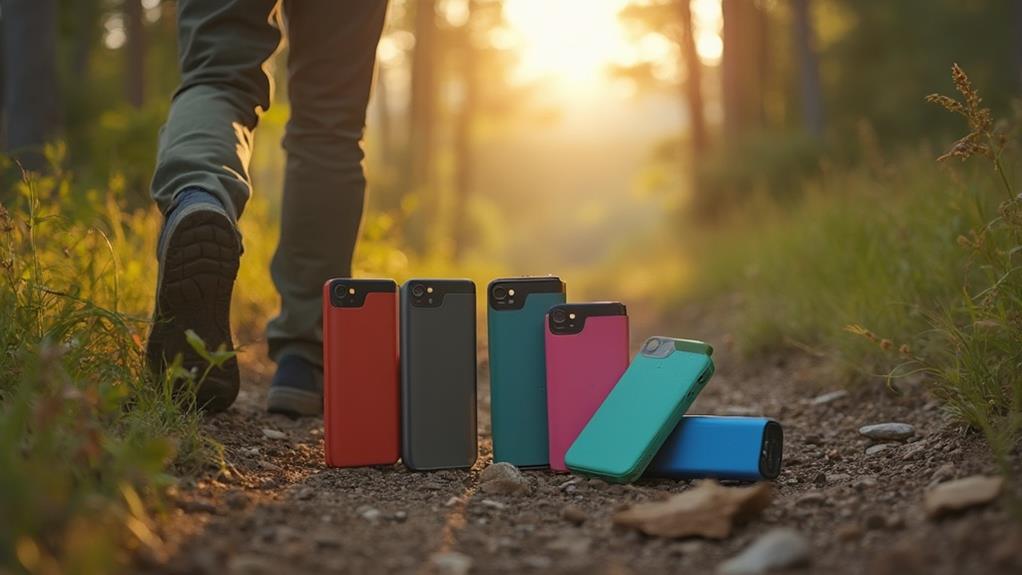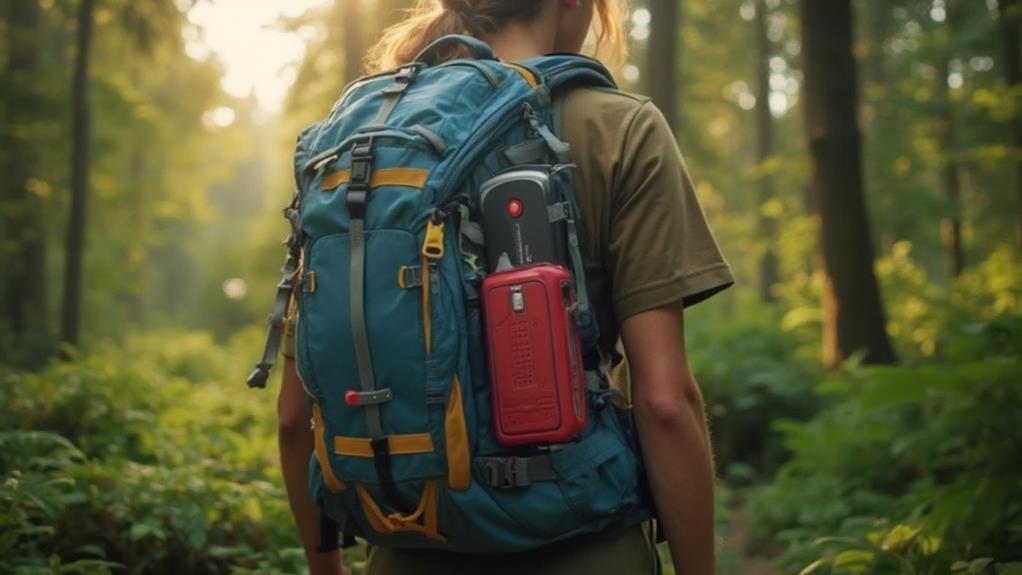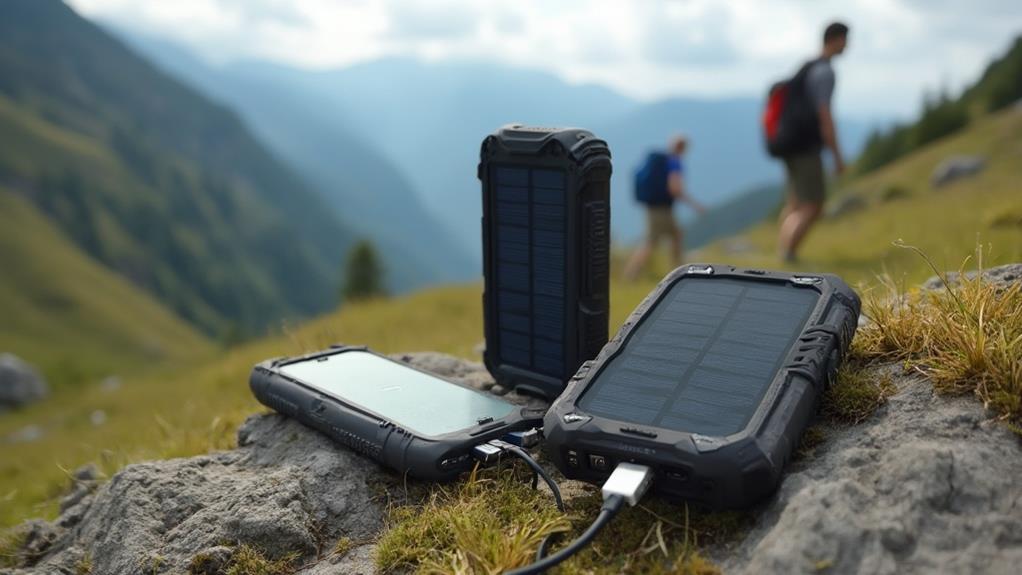Choosing the best portable power bank for hiking involves evaluating essential criteria like capacity, durability, portability, and charging capabilities. Opt for a model with at least 10,000mAh, which typically allows around three smartphone charges. Durability features, such as an IP67 rating, guarantee your power bank withstands harsh environments. Prioritize lightweight and compact models to maintain ease of movement during hikes. Fast-charging compatibility, multiple ports, and additional features like built-in lights enhance functionality. Brands like Anker and Goal Zero provide reliable options. Delving deeper into each aspect will equip you with the knowledge to make an informed decision.
Key Takeaways
- Choose a power bank with at least 10,000mAh capacity to ensure sufficient recharges for smartphones and essential devices.
- Opt for models with an IP67 rating or higher for water and dust resistance during outdoor adventures.
- Prioritize lightweight and compact designs for easy portability and comfort on long hikes.
- Select power banks with fast charging capabilities, like 20W PD, to minimize device recharge time.
- Consider additional features like built-in lights, multiple charging ports, and LED indicators for enhanced usability and convenience.
Importance of Power Banks
In the domain of outdoor adventures, particularly hiking, power banks serve as an indispensable tool for maintaining connectivity and guaranteeing safety. They are essential for charging important devices like smartphones, GPS units, and headtorches, which are imperative for navigation and emergency communication.
One of the key safety considerations when selecting a power bank is its charging speed, as this can determine how quickly you can restore power to your devices in critical situations. A power bank with fast charging capabilities guarantees that devices are ready for use in minimal time, reducing the risk of being disconnected during hikes.
Moreover, power banks with a capacity of around 10,000mAh are highly recommended, as they can recharge a smartphone approximately three times. This guarantees an adequate power supply for extended treks or unexpected delays.
Durability is another essential factor; opting for models with an IP67 rating is advisable to protect against harsh outdoor conditions like water and dust. Additionally, the convenience factor is enhanced by the ability to charge multiple devices simultaneously, making it ideal for group excursions.
A reliable power bank not only enhances the hiking experience but also provides peace of mind by guaranteeing continuous access to essential technology.
Evaluating Capacity Needs

Determining the appropriate capacity for a power bank is essential for guaranteeing that hikers remain powered throughout their journey. Analyzing your power consumption needs begins with understanding the devices you intend to charge.
Smartphones generally require 2,500 to 3,500mAh per full recharge, so a power bank with a capacity of 10,000mAh can typically recharge a smartphone approximately three times. For day hikes, this capacity is often sufficient, but longer excursions may demand a power bank with a capacity of 20,000mAh or more, especially if multiple devices are involved.
Device compatibility is another critical factor to take into account. Confirm that the power bank can efficiently recharge all intended devices, including smaller gadgets like headtorches, which consume less power.
Total watt-hours (Wh) provided by the power bank is a useful metric for analyzing overall efficiency and suitability, as it accounts for both voltage and capacity.
Additionally, external conditions such as temperature can influence battery performance. Cold weather can reduce efficiency, so selecting a power bank with a slightly higher capacity is advisable for winter hikes.
Assessing Durability
Durability is a cornerstone of selecting a suitable portable power bank for hiking. When venturing into the wilderness, the power bank must endure diverse environmental challenges.
Prioritize models with weather resistance, specifically those carrying an IP67 rating or higher. This rating guarantees the power bank is shielded against dust and water, safeguarding it from unpredictable weather conditions.
The following factors are essential in evaluating durability:
- Weather Resistance: Opt for power banks with an IP67 rating or above to guarantee protection against dust and water, vital for hiking in varied climates.
- Material Quality: Choose power banks constructed from high-quality materials like aluminum or reinforced plastics. These materials enhance the device's ability to withstand physical stress and environmental factors.
- Shock Resistance: Rugged models such as the RUGD. Power Brick are designed to resist drops and shocks, ideal for rough terrains typically encountered during hiking.
- Additional Features: Consider power banks with built-in lights or carabiners. These features improve usability and guarantee the power bank remains securely attached to your gear.
Portability and Weight

While durability remains a vital factor for outdoor enthusiasts, the portability and weight of a power bank are just as significant for a successful hiking experience. Lightweight options and compact designs are essential elements to take into account, as they directly impact your endurance and comfort during long treks.
Prioritizing a high power-to-weight ratio is important; models like the Anker Nano Power Bank, weighing a mere 215g, exemplify this balance, offering convenience without sacrificing charging capabilities.
When evaluating power banks, reflect on the capacity versus weight trade-off. A 10,000mAh power bank typically ranges between 200g to 300g, striking an effective balance between charging capacity and carry weight. Compact designs, such as those offered by credit card-sized models, enhance portability, easily fitting into pockets or small compartments of hiking gear. This guarantees that your device is accessible without encumbering your load.
Conversely, heavier power banks, like the Goal Zero Venture 75 at 577g, may provide larger capacities but can impede mobility and comfort during extended hikes. Testing how a power bank fits within your backpack or carry system is recommended, as bulkier models may restrict space for other essential gear, impacting overall efficiency and preparedness.
Reviewing Power Bank Features
Choosing the right power bank for hiking requires a thorough evaluation of its features, as these directly affect its performance and suitability for outdoor activities. A key consideration is the capacity, with at least 10,000mAh recommended for hiking trips, offering the ability to recharge a smartphone approximately three times.
However, the choice of charging ports and fast charging capabilities can notably enhance the user experience.
- Charging Ports: Consider the number and type of output ports. USB-A and USB-C ports are prevalent, and having multiple ports allows simultaneous charging of several devices, an essential feature during hikes.
- Fast Charging: Opt for power banks with 20W PD fast charging capabilities to reduce device recharge time, guaranteeing your gadgets are quickly ready for use.
- Weight and Size: Higher capacity power banks typically weigh more. Compact models like the Anker Nano Power Bank offer a balance, weighing only 215g with a 10,000mAh capacity.
- Durability: An IP rating for water and dust resistance is vital for hiking. For instance, the Goal Zero Venture 75's IP67 rating makes it ideal for rugged outdoor conditions.
These features collectively guarantee a reliable and efficient power source for your hiking adventures.
Top Power Banks for 2024

Often, choosing the right power bank for hiking in 2024 hinges on balancing capacity, durability, and weight, tailored to specific outdoor needs. Brand comparisons reveal the Goal Zero Venture 75 as a standout option, offering 19,200mAh capacity and an IP67 rating for water and dust resistance, priced at £135. Its robust design and high user reviews underscore its reliability for challenging environments.
Meanwhile, the RUGD. Power Brick provides excellent value at £39.99, with a 10,050mAh capacity and a built-in light, making it a practical choice for rugged terrain.
For those prioritizing ultralight gear, the Biolite Charge 40 PD is a compact, pocket-sized solution at 10,000mAh, weighing only 265g, and retailing for £54.99. Its portability is echoed in positive user feedback, emphasizing convenience for minimalist hikers.
On the other end of the spectrum, the Anker 521 PowerHouse offers a substantial 256Wh capacity suitable for charging multiple devices during extended trips, though its 4.34 kg weight and £219 price tag may be considerations for potential buyers.
Lastly, the Anker Nano Power Bank provides a more compact option at 10,000mAh and 215g, priced at £39.99, though it lacks weatherproofing, which is a key factor in user reviews.
Frequently Asked Questions
What Size Powerbank for Hiking?
For hiking, select a power bank with a power capacity of 10,000mAh for day trips or 20,000mAh for multi-day excursions. Prioritize weight consideration to guarantee portability without sacrificing necessary device recharging capabilities.
Which Power Bank Is Better 10000MAH or 20000MAH?
When determining whether a 10,000mAh or 20,000mAh power bank is preferable, consider power bank efficiency and charging speed. A 20,000mAh offers more charges but may reduce portability, whereas a 10,000mAh is lighter and often sufficient.
How Do I Choose a Good Quality Power Bank?
To select a high-quality power bank, evaluate its battery lifespan and charging speed. Prioritize models with advanced battery management systems ensuring longevity and those equipped with fast charging technologies for efficient and rapid device recharging.
What Is the Difference Between 5000MAH and 20000MAH?
The primary difference between 5000mAh and 20000mAh power banks lies in capacity comparison and charging speed. A 20000mAh unit offers greater capacity for multiple charges and supports faster charging, but requires more time to recharge itself.
Conclusion
In summary, selecting the ideal portable power bank for hiking necessitates a thorough understanding of capacity requirements, durability, and portability. Evaluating these factors guarantees that the power bank can meet energy demands while withstanding environmental conditions typically encountered during outdoor activities. Additionally, careful consideration of advanced features, such as fast-charging capabilities and multiple charging ports, enhances functionality. By synthesizing technical knowledge, expert recommendations, and practical insights, outdoor enthusiasts can make informed decisions, securing reliable power supply on their hiking ventures.